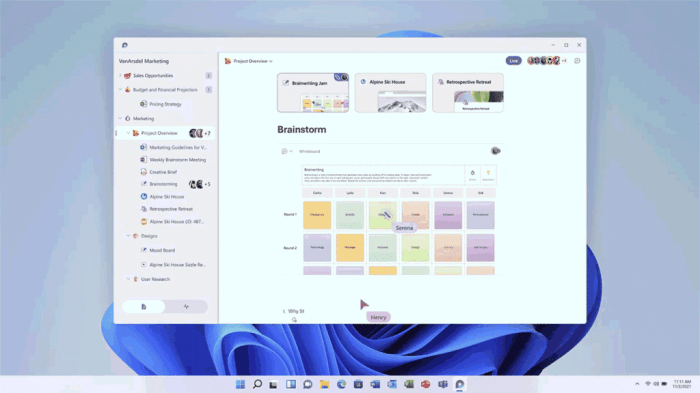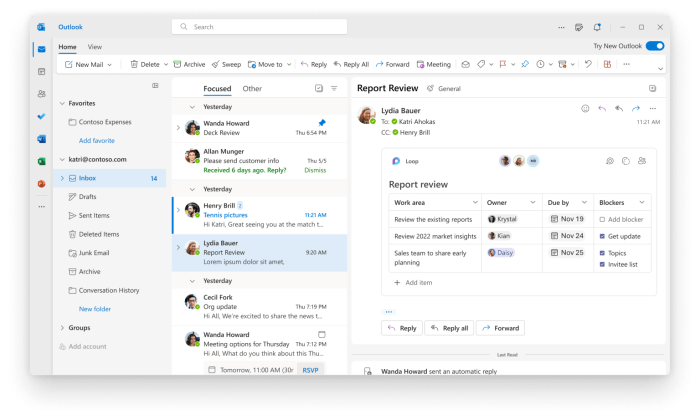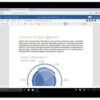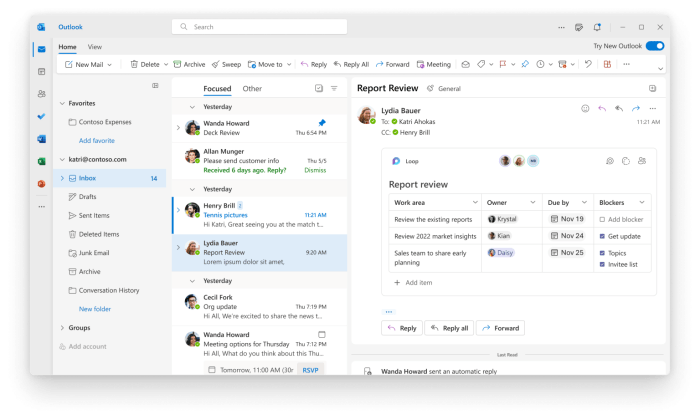Microsoft Loop Fluid Components Office Collaboration App is revolutionizing how teams work together. Imagine seamless real-time collaboration, effortless document editing, and integrated workflows across all your Office applications. This innovative approach leverages Fluid Components to create a dynamic and intuitive experience, transforming the way we approach teamwork.
This exploration delves into the core functionalities of Microsoft Loop Fluid Components, examining how they facilitate co-authoring, version control, and integration with other Office applications. We’ll also discuss the user experience, security considerations, and potential use cases across various industries. Get ready to understand how these components are redefining office collaboration.
Introduction to Microsoft Loop Fluid Components
Microsoft Loop is a collaborative workspace designed to foster seamless teamwork and document co-creation. It’s built on the concept of “living documents” that adapt and evolve as users contribute. Crucially, Loop leverages Fluid Framework to enable real-time collaboration and dynamic interactions within these documents.Fluid Components are the building blocks of this dynamic experience within Loop. They’re reusable, adaptable components that empower users to build and modify documents collaboratively, in real time, all within a single, shared environment.
This dynamic nature of Fluid Components is central to Loop’s collaborative capabilities. They break down the traditional barriers of document editing, allowing users to work together on the same content simultaneously, see changes in real-time, and maintain a shared understanding of the document’s evolution.
Fluid Components and Collaborative Features
Fluid Components enable real-time collaboration within Loop by embedding interactive elements directly into the document. This eliminates the need for separate applications or tools for tasks like data entry, form filling, or task management. By integrating these functionalities directly within the Loop document, users can easily interact and contribute, enhancing efficiency and responsiveness.
Core Functionalities of Fluid Components in Office Collaboration
Fluid Components are designed to streamline various Office collaboration tasks. They enable users to embed interactive elements, such as live spreadsheets, forms, or task lists, directly into the document, promoting dynamic interaction and data flow. These components update automatically in real-time, ensuring all collaborators have access to the most current information. They also allow for the seamless integration of data from other sources, enabling a unified and comprehensive collaborative workspace.
Microsoft Loop’s fluid components are a game-changer for office collaboration, but if you’re looking for a quick deal on a Fitbit Inspire 3, check out the QVC Star Wars Outlaws preorder fitbit inspire 3 deal sale here. It’s cool how these features seamlessly integrate, letting teams work together more effectively. Loop’s adaptable structure is a real plus, and I’m excited to see how it evolves.
This integration of different data sources ensures a streamlined and unified work environment, eliminating the need to switch between various tools for different tasks.
Types of Fluid Components and Use Cases
The diverse nature of Fluid Components makes them highly adaptable to various collaborative scenarios. They are not confined to a single purpose but rather act as flexible building blocks.
| Fluid Component Type | Typical Use Case in Collaborative Setting |
|---|---|
| Fluid Data Grid | Facilitates collaborative data entry and management. Teams can simultaneously update and view data within a structured table format, ideal for tasks like project tracking, inventory management, or data collection. |
| Fluid Forms | Allows for interactive form creation and submission within the document. This streamlines data collection and feedback gathering, enabling users to collaboratively input and manage information. |
| Fluid Kanban Board | Visualizes and manages tasks in a dynamic Kanban board format, enabling teams to track progress, assign tasks, and collaboratively manage workflows. |
| Fluid Spreadsheet | Embeds interactive spreadsheets within the Loop document, facilitating real-time data analysis, calculations, and collaborative updates. Ideal for project budgets, financial reporting, or any data-driven collaborative process. |
Collaboration Features Enabled by Fluid Components
Microsoft Loop, with its Fluid Components, is revolutionizing how we collaborate on documents. These components offer a powerful, real-time, and shared experience, moving beyond the limitations of traditional file-sharing methods. They are designed for seamless co-authoring, version control, and concurrent access, fundamentally changing the dynamics of teamwork.Fluid Components in Microsoft Loop leverage the power of the cloud to allow multiple users to work on the same document simultaneously.
This collaborative environment fosters a more efficient and productive workflow, where ideas can flow freely and documents evolve in real-time.
Real-time Co-authoring
Fluid Components enable real-time co-authoring, a critical feature for modern collaboration. Multiple users can edit a document simultaneously, seeing changes instantly reflected on the screen. This dynamic approach eliminates the need for back-and-forth revisions, emails, or multiple versions of a document. Imagine a team working on a project proposal – each member can add their input as it comes, with all changes visible in real-time.
Shared Document Editing, Microsoft loop fluid components office collaboration app
Fluid Components fundamentally change how shared documents are managed. They break down the traditional barrier of single-user editing. By allowing multiple users to contribute concurrently, documents are more dynamic and responsive to the needs of the entire team. This real-time interaction is vital in brainstorming sessions, project planning, and collaborative writing projects.
Microsoft Loop’s fluid components are a game-changer for office collaboration, but sometimes tech updates can cause unexpected issues. Just like Samsung recently addressed battery drain problems on the Galaxy S21 with a new update ( samsung rolls out new update fix galaxy s21 battery drain issue ), seamless integration and reliable performance are crucial for any productive workflow.
Loop’s flexible design is precisely what’s needed for teams to stay connected and efficient.
Version Control and Change Tracking
Fluid Components maintain a detailed history of changes to documents, enabling robust version control. This capability is essential for tracking revisions, identifying the source of specific edits, and reverting to previous versions if needed. This historical record is invaluable for teams needing to revisit past decisions or identify who made particular modifications. Imagine a team developing a complex technical document – the version history allows for an audit trail and the ability to understand the evolution of ideas.
Concurrent Access and Editing
Fluid Components allow for concurrent access and editing, fostering true parallel work. Multiple users can edit the same document at the same time without interference. This feature is critical for teams working across different time zones or with diverse schedules. Consider a team working on a global project – fluid components allow them to collaborate efficiently regardless of their location or schedule.
Comparison with Traditional Office Applications
Traditional Office applications often require a save-and-send workflow, creating a delay and potential for version conflicts. Fluid Components, on the other hand, provide a real-time, collaborative environment, significantly streamlining the process. The ability to edit and view changes concurrently is a major advantage over older methods.
Advantages and Disadvantages of Using Fluid Components
| Feature | Advantages | Disadvantages |
|---|---|---|
| Real-time Collaboration | Improved efficiency, reduced delays, instant feedback | Requires reliable internet connection, potential for conflicts if not managed carefully |
| Version Control | Detailed change history, easy rollback, improved accountability | Complexity in managing numerous versions for very large files |
| Concurrent Access | Facilitates work across different time zones, enhanced productivity | Potential for conflicts if multiple users edit the same section simultaneously |
| Integration with Loop | Seamless integration with other Loop features, holistic workflow | Limited compatibility with older Office documents |
Integration with Other Office Applications

Microsoft Loop’s Fluid Components are designed to seamlessly integrate with other Microsoft Office applications, fostering a unified and collaborative workspace. This integration empowers users to leverage the strengths of different Office tools within a single, dynamic environment, enhancing workflow efficiency and data consistency. The key is in the Fluid Framework’s ability to connect and synchronize data across various applications, eliminating data silos and promoting a more holistic approach to work.
Enhanced Workflow Across Applications
Fluid Components enable a more streamlined workflow by facilitating data exchange and real-time collaboration across different Office applications. This interconnectedness removes the friction often associated with switching between various tools and promotes a more unified user experience. Instead of isolated documents, users can now work within a shared, evolving environment, ensuring everyone is on the same page and contributing to a common goal.
Seamless Data Exchange Examples
Fluid Components facilitate seamless data exchange between Loop and other Office apps. For instance, a user working on a project proposal in Word can embed a Fluid-powered table directly into the document. This table, which could track project milestones or budget allocations, is then automatically updated in real-time in Loop, allowing team members to access and contribute to the information simultaneously.
Similarly, data visualizations created in Power BI can be integrated into a Loop workspace, providing real-time insights to stakeholders.
Data Consistency and Synchronization
Fluid Components ensure data consistency and synchronization across different Office applications by leveraging a shared, real-time data model. Changes made in one application are instantly reflected in others, eliminating discrepancies and promoting a single source of truth. This eliminates the need for manual data entry and reconciliation across different applications, saving time and reducing errors.
Automation of Tasks and Workflows
Fluid Components empower the automation of tasks and workflows by connecting different Office applications in a dynamic way. For example, a task list created in Outlook could be automatically linked to a Fluid-powered project board in Loop. This linkage could trigger notifications, updates, or even automate the assignment of tasks to team members. This automation capability is a major improvement for large projects and complex workflows.
Use Cases for Integration
| Office Application | Use Case | Description |
|---|---|---|
| Word | Project Proposals | Embed Fluid tables for tracking milestones, budget, or tasks. Real-time updates are reflected in Loop. |
| Excel | Data Analysis and Reporting | Integrate data from Excel spreadsheets into Loop workspaces. Fluid Components allow real-time analysis and reporting dashboards. |
| PowerPoint | Presentations and Visualizations | Embed interactive charts and graphs from Power BI into Loop presentations. Allow users to interact and update data in real-time. |
| Outlook | Task Management | Link task lists in Outlook to Fluid-powered project boards in Loop. Automating task assignment, progress tracking, and notifications. |
| Teams | Communication and Collaboration | Integrate chat functionality with Fluid-powered documents. Allow team members to comment and collaborate on documents within the chat interface. |
User Experience and Interface
Microsoft Loop’s Fluid Components aim for a seamless and intuitive user experience, particularly in collaborative environments. This approach emphasizes a dynamic and responsive interface, adapting to the needs of real-time interaction. The core design principle is to minimize friction and maximize user engagement, allowing for effortless collaboration on shared documents and data. Fluid Components prioritize a sense of presence and immediacy, mirroring the experience of working with physical documents in a shared space.The intuitive design principles behind Fluid Components are built around a deep understanding of user behavior and collaboration patterns.
This involves leveraging familiar interfaces and interactions to ensure a smooth transition for users accustomed to traditional Office applications. For example, the design of Fluid Components often employs familiar drag-and-drop functionality and visual cues to guide users through the collaborative process. This approach reduces the learning curve, enabling users to quickly grasp and utilize the collaborative features.
Fluid Component Interface Design
Fluid Components in Microsoft Loop prioritize a clean and uncluttered interface. Visual elements are strategically placed to highlight relevant information and actions. For instance, real-time updates and changes are clearly signaled, keeping users informed about the evolving state of the shared document or data. The design language aligns with Microsoft’s broader design principles, fostering a consistent and recognizable user experience across different applications.
This approach creates a sense of familiarity and predictability, allowing users to quickly locate and interact with relevant features.
Intuitive Design Principles
The intuitive design principles of Fluid Components stem from a user-centered design process. Focus groups and usability testing have guided the design decisions, ensuring the components are easy to use and navigate. The principles include:
- Visual Cues: Clear visual cues, such as highlighting changes and real-time updates, keep users informed about the evolving state of the shared document or data. This proactive approach reduces the need for users to actively search for updates.
- Familiar Interactions: Familiar interactions, such as drag-and-drop, are leveraged to maintain a consistent and user-friendly experience, reducing the learning curve and increasing efficiency.
- Contextual Design: The design adapts to the specific context of the task, dynamically adjusting the layout and information presented to the user. This ensures the most relevant information is always readily accessible.
Improving User Engagement in Collaborative Work
Fluid Components enhance user engagement by fostering a sense of shared presence and real-time interaction. Users can actively participate in the collaboration process, viewing and contributing to the work as it evolves. The dynamic nature of Fluid Components keeps users engaged and motivated to contribute, fostering a more collaborative and productive environment.
User Experience Benefits in Real-Time Collaboration
Fluid Components in real-time collaboration offer several user experience benefits. These include:
- Improved Efficiency: Real-time updates minimize delays and bottlenecks, allowing users to work together more efficiently and effectively.
- Enhanced Communication: Instant feedback and real-time interaction promote seamless communication and reduce misunderstandings.
- Increased Productivity: The streamlined collaboration process allows teams to complete tasks more quickly and achieve greater productivity.
Customizability of Fluid Components
Fluid Components are designed to be highly customizable, allowing users to tailor the interface to specific needs. This includes the ability to adjust colors, layouts, and functionality to match the specific workflow or requirements of the project. For instance, a project team working on a complex financial model could customize Fluid Components to better visualize and interact with financial data.
Accessibility Design Considerations
Accessibility is a crucial aspect of Fluid Component design. Components should adhere to established accessibility guidelines, such as WCAG standards. This includes considerations for screen readers, keyboard navigation, and alternative text for images. For example, providing clear labels and descriptions for all interactive elements ensures usability for users with disabilities. Using color contrast and font sizes that are easy to read further enhances accessibility.
These measures ensure the collaborative tools are accessible to a wider range of users, promoting inclusivity and equity.
Security and Privacy Considerations
Microsoft Loop’s Fluid Components are designed with robust security measures to protect sensitive data during collaborative work. This crucial aspect ensures user trust and confidence in the platform, enabling seamless and secure information sharing. These measures are paramount in maintaining the integrity and confidentiality of data within shared documents and applications.Data security and privacy are paramount in a collaborative environment.
Microsoft Loop’s fluid components are revolutionizing office collaboration, making it easier than ever to share ideas and projects. Imagine seamless workflows, where everyone can contribute in real-time. This kind of dynamic approach is crucial in today’s fast-paced business world, especially when considering the precision and reliability needed for tasks like those handled by industrial drones, such as the DJI Drone Matrice 200 industrial enterprise dji drone matrice 200 industrial enterprise.
Loop’s adaptability to diverse needs ultimately helps streamline processes, just like these advanced drones. These features make Loop an excellent choice for any modern business looking to improve its collaborative efforts.
Fluid Components implement various mechanisms to address these concerns, ranging from access control to data integrity checks. These mechanisms are crucial to prevent unauthorized access, data breaches, and maintain the confidentiality of sensitive information.
Security Measures Implemented in Fluid Components
Fluid Components leverage a multi-layered approach to security. This includes employing industry-standard encryption protocols to protect data in transit and at rest. The system’s architecture is designed with security at its core, mitigating potential vulnerabilities and ensuring data integrity throughout the collaborative process.
Data Privacy and Confidentiality
Fluid Components prioritize data privacy and confidentiality by employing end-to-end encryption. This ensures that only authorized users can access the data, regardless of where it is stored or who is accessing it. Furthermore, data access is meticulously controlled using granular permissions, restricting access to specific information based on user roles and responsibilities.
Access Controls and Permissions
Granular access control is a cornerstone of Fluid Components’ security architecture. Permissions are meticulously defined for each user, ensuring that they can only access and modify data they are authorized to. This includes features like read-only access, edit permissions, and specific permissions for different actions. This ensures that only authorized users can modify or access specific data, preserving data confidentiality.
Data Integrity Maintenance
Fluid Components maintain data integrity through versioning and audit trails. Each change made to the shared document is tracked, allowing for easy rollback to previous versions if necessary. This meticulous versioning system ensures that data remains consistent and accurate throughout the collaborative process. Furthermore, the audit trails provide transparency into who made changes, when, and what those changes were, enhancing accountability and reducing the risk of malicious activity.
Data Protection Measures for Collaborative Work
Robust data protection is critical for secure collaborative work in Fluid Components. This involves a combination of encryption, access control, and data integrity mechanisms. These combined measures ensure the confidentiality, integrity, and availability of the data shared through the platform. This comprehensive approach strengthens data security, thereby protecting the interests of all users.
Security Features Implemented in Fluid Components
| Feature | Description |
|---|---|
| End-to-End Encryption | Data is encrypted from the source to the destination, ensuring only authorized users can access it. |
| Granular Access Control | Permissions are meticulously defined for each user, restricting access to specific data based on roles and responsibilities. |
| Versioning and Audit Trails | Changes are tracked, enabling easy rollback to previous versions and transparency into who made changes and when. |
| Secure Data Storage | Data is stored securely, with access restricted to authorized personnel. |
Potential Use Cases and Future Trends
Microsoft Loop’s Fluid Components promise a revolutionary approach to collaborative work, moving beyond static documents and spreadsheets towards dynamic, real-time experiences. This dynamic nature opens doors to numerous potential use cases across various industries, transforming how teams work together and fostering unprecedented levels of efficiency. The future of collaboration is increasingly intertwined with Fluid Components, promising to reshape business processes and enhance productivity.
Potential Use Cases Across Industries
Fluid Components’ adaptability allows for their application in diverse industries. In healthcare, Fluid Components can power dynamic patient records, enabling seamless information sharing among doctors and other care providers. Project management teams can leverage Fluid Components to create collaborative workspaces where tasks, deadlines, and progress are visible and instantly updated. In customer service, Fluid Components can facilitate real-time interaction and knowledge sharing, improving response times and resolving customer issues efficiently.
Marketing teams can employ Fluid Components to build dynamic landing pages and interactive content, driving engagement and enhancing data analysis. Financial institutions can benefit from Fluid Components in areas like risk management and compliance, providing a collaborative environment for analysis and reporting. These are just a few examples, highlighting the potential for Fluid Components to revolutionize diverse industries.
Transforming Business Processes
Fluid Components can dramatically alter existing business processes. For example, in a manufacturing setting, Fluid Components can facilitate real-time updates on production lines, allowing for quicker responses to equipment failures or material shortages. In a research lab, Fluid Components can be used to create shared data visualization tools, accelerating scientific discovery and analysis. These examples demonstrate the potential for Fluid Components to streamline and optimize workflows in numerous industries.
Enhancing Team Productivity and Efficiency
Fluid Components inherently enhance team productivity and efficiency. Their real-time collaboration capabilities enable simultaneous work on shared documents, reducing the time spent on revisions and communication delays. The centralized, shared workspace fosters a culture of transparency and collaboration, empowering team members to stay informed and aligned. The streamlined workflows minimize redundancies and increase efficiency, allowing teams to focus on core tasks and achieve results more quickly.
Future Improvements to Fluid Components
Several improvements to Fluid Components are conceivable and desirable:
- Enhanced integration with existing third-party tools and platforms.
- More sophisticated version control and conflict resolution mechanisms.
- Support for more complex data types and models.
- Improved accessibility features for users with disabilities.
- More robust security protocols and data encryption options.
These improvements will increase the versatility and usability of Fluid Components, ultimately empowering teams to work together more effectively.
Fluid Components in Action
Examples of Fluid Components in various scenarios:
- Project Management: A team can create a shared project board in Microsoft Loop, allowing members to add tasks, assign responsibilities, and track progress in real time. The project board automatically updates with new information, ensuring everyone stays informed. Fluid Components can connect to other applications for task management, such as task lists, calendars, and communication tools.
- Customer Service: A customer service representative can access a shared customer database in Microsoft Loop, enabling instant access to customer history, preferences, and support interactions. This real-time information sharing helps representatives provide more effective and personalized support.
- Product Development: A design team can use Fluid Components to collaboratively create and edit product prototypes, allowing for real-time feedback and iterations. Version control within the Fluid Component enables the team to track changes and revert to previous versions if needed.
These examples illustrate the potential of Fluid Components to streamline and improve collaborative workflows across diverse industries.
Last Point: Microsoft Loop Fluid Components Office Collaboration App

In conclusion, Microsoft Loop Fluid Components offer a powerful and flexible platform for collaborative work, integrating seamlessly with existing Office applications. The intuitive design, robust security measures, and diverse potential use cases position it as a transformative tool for enhancing team productivity and efficiency. Whether it’s project management, customer service, or any other collaborative endeavor, Fluid Components promise a brighter future for teamwork.





